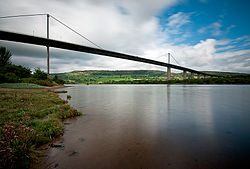Erskine Bridge | |
|---|---|
 View of the Erskine Bridge from the south bank of the River Clyde | |
| Coordinates | 55°54′48″N 4°28′20″W / 55.9133°N 4.4721°W |
| Carries | Motor vehicles, cyclists, pedestrians |
| Crosses | River Clyde |
| Locale | Erskine, Scotland |
| Official name | Erskine Bridge (A898) |
| Maintained by | Transport Scotland |
| Characteristics | |
| Design | Box girder bridge |
| Material | Steel, concrete |
| Total length | 1,321.87 m (4,336.8 ft) |
| Width | 31.25 m (102.5 ft) |
| Height | 45 m (148 ft) |
| Longest span | 305 m (1,001 ft) |
| No. of spans | 15 |
| Load limit | 500 t (490 long tons; 550 short tons) |
| Design life | 120 years[1] |
| History | |
| Architect | R.E. Slater |
| Designer | William Brown |
| Constructed by | Freeman Fox & Partners, W.A.Fairhurst and Partners, Christiani & Nielsen, Lehane, Mackenzie and Shand Ltd |
| Fabrication by | Fairfields-Mabey |
| Construction start | 1967 |
| Construction cost | £10.5 million |
| Inaugurated | 2 July 1971 |
| Replaces | Erskine Ferry |
| Statistics | |
| Daily traffic | ~35,000 vehicles |
| Toll | Free |
| Location | |
 | |
The Erskine Bridge is a multi span cable-stayed box girder bridge spanning the River Clyde in west central Scotland.[2] The bridge connects West Dunbartonshire with Renfrewshire and can be used by all types of motor vehicles, cyclists and pedestrians. As well as crossing the Clyde, the bridge also crosses the Forth and Clyde Canal and the North Clyde railway line. A small part of Kilpatrick railway station is situated underneath the bridge at the north side. The bridge is part of the A898 road.[3] On completion the bridge replaced the Erskine to Old Kilpatrick ferry service.[4]
- ^ "Erskine Bridge Tolls Act 1968: Erskine Bridge Accounts 2005-06". Scotland.gov.uk. 30 November 2006. Archived from the original on 4 January 2014. Retrieved 18 February 2014.
- ^ "Construction of the Erskine Bridge". Erskinebridge.co.uk. Archived from the original on 13 December 2013. Retrieved 31 December 2013.
- ^ "The M898/A898 Trunk Road (Erskine Bridge) (Temporary Prohibition of Traffic and 40mph Speed Restriction) Order 2013" (PDF). legislation.gov.uk. 22 May 2013. Archived (PDF) from the original on 17 February 2019. Retrieved 3 January 2014.
- ^ Historic Environment Scotland. "Erskine Ferry River Clyde (222560)". Canmore. Retrieved 19 January 2014.
